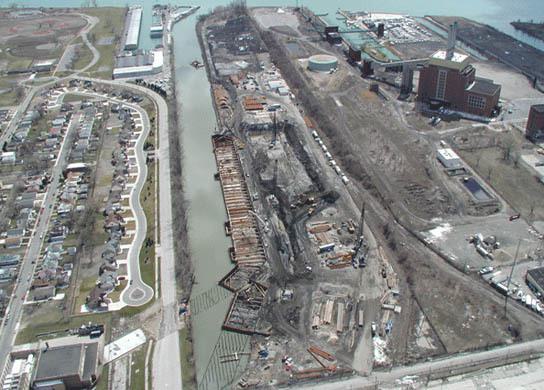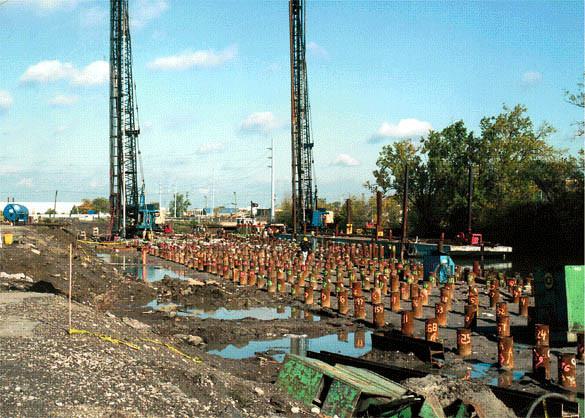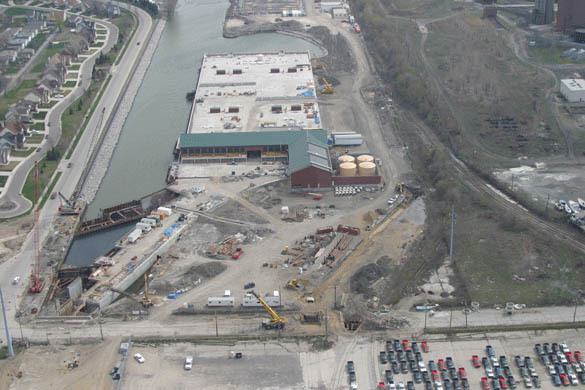Conner Creek CSO Control Facility: Michigan's Largest
The Detroit Water and Sewerage Department retained Hazen and Sawyer as the lead of a multi-disciplinary team to assist in the planning, design, and construction oversight of a new CSO Control Facility to screen, settle, and disinfect all flow up to the 10-year, 1-hour event.
When storm flows overloaded Detroit’s combined sewer system, untreated wastewater flowed from three outfalls into Conner Creek, a half-mile-long tributary to the Detroit River. This constituted the largest CSO discharge in the state of Michigan, totaling about two billion gallons per year. Due to the enormous volume and widely fluctuating nature of these discharges (ranging from less than 500 to over 14,000 cubic feet per second), controlling these flows presented a complex engineering challenge.
Project Outcomes and Benefits
- Largest CSO control facility in the state of Michigan, serving as a model for other major CSO projects.
- Eliminates up to two billion gallons of untreated discharge to Conner Creek annually.
- Set the stage for regulatory changes that may reduce disinfection contact time from 10 to 5 minutes, significantly lowering treatment costs.
- Instituted CxT disinfection control, minimizing chemical usage and total residual chlorine, and leading to implementation at other facilities.
- Included removal of 160,000 cubic yards of contaminated sediment deposits from Conner Creek, thereby eliminating objectionable sediment-generated odors.
- Redevelopment of 8.5 acres of an urban park, including creation of a 1.75 acre oxbow and fish habitat pond, a walking path, barrier free fishing pier, a gazebo, an island with native prairie grass plantings, and interpretive signage describing native plants and fish.
- Work was completed four months ahead of schedule and within its construction budget.
- The facility can store up to 62 million gallons of combined sewage during a storm event, and subsequently convey it to DWSD’s wastewater treatment facility after the storm has subsided.

Peter Young serves as Hazen’s corporate CSO Group Leader, and his areas of expertise include CSO facility planning and design, BNR planning and design, and wastewater treatment.
Related Topics:
Our Work
The Conner Creek CSO facility eliminates up to two billion gallons of untreated discharge annually.

Hazen and Sawyer spearheaded a team to perform several studies to establish key design criteria for the new CSO control facility. These included:
- Disinfection study - to evaluate bacterial reduction and various combinations of disinfectant dose and contact time. Also examined degradation of sodium hypochlorite solutions during storage, to determine disinfection equipment sizing.
- Mixing study - using Computerized Fluid Dynamics (CFD) modeling to evaluate various mixing technologies and optimize sizing of mixing equipment. This was followed by full-scale, large-channel testing at an independent laboratory, to determine how effectively disinfectant would be dispersed.
- Hydraulic and automation control studies - to ensure the ability to control peak flows over the wide range that would be experienced.
These studies provided the necessary design parameters for the new CSO Control Facility, confirming its ability to meet permit requirements with five minutes of contact time at the 10-year, one hour peak flow of 13,262 cubic feet/second (8.6 billion gallons/day). Without these studies, the Michigan Department of Environmental Protection would have required the facility to provide ten minutes of contact time, doubling its size to 60 mgd, and significantly increasing its construction and operating costs.
The design included several innovative features. For example, flushing gates were provided to flush the basin of debris in a cost-effective and operationally simple manner, with low maintenance requirements – the first application of this European technology in the US. Also, a new dewatering technology, known as Geotubes, was used to dewater dredged sediment, combining hydraulically-dredged sediment with chemical polymers in large flexible fabric containers, enabling both the container and its sufficiently dewatered contents to be disposed of at a landfill after 30 days.


The Hazen and Sawyer team designed the facility to fit within a tight site. Construction required carefully-sequenced deep excavation (14 separate stages), involving the driving of 6,700 piles into soft clay soils, coupled with earth retention systems to avoid slope failure. Soil from the excavation was reused as backfill, saving millions of dollars compared with landfilling excavated soils and importing clean fill. Over 110,000 cubic yards of cast-in-place concrete and 16,000 tons of reinforcing steel were used in constructing the facility. Throughout the construction period, two existing CSO pumping stations and conveyance structures were maintained in operation.

The facility was completed in July 2005, four months ahead of the date mandated by DWSD’s NPDES permit, and within the budget. The facility’s performance has met or exceeded all treatment objectives state in the NPDES permit.





















